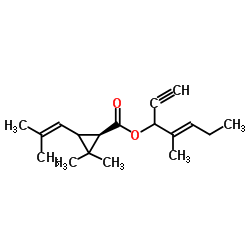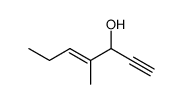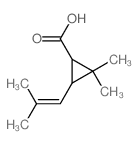empenthrin

empenthrin structure
|
Common Name | empenthrin | ||
|---|---|---|---|---|
| CAS Number | 54406-48-3 | Molecular Weight | 274.398 | |
| Density | 1.0±0.1 g/cm3 | Boiling Point | 346.0±42.0 °C at 760 mmHg | |
| Molecular Formula | C18H26O2 | Melting Point | N/A | |
| MSDS | Chinese USA | Flash Point | 144.0±25.3 °C | |
| Symbol |


GHS07, GHS09 |
Signal Word | Warning | |
| Name | empenthrin |
|---|---|
| Synonym | More Synonyms |
| Density | 1.0±0.1 g/cm3 |
|---|---|
| Boiling Point | 346.0±42.0 °C at 760 mmHg |
| Molecular Formula | C18H26O2 |
| Molecular Weight | 274.398 |
| Flash Point | 144.0±25.3 °C |
| Exact Mass | 274.193268 |
| PSA | 26.30000 |
| LogP | 6.35 |
| Vapour Pressure | 0.0±0.8 mmHg at 25°C |
| Index of Refraction | 1.527 |
| Storage condition | 2-8°C |
| Stability | Stable. Incompatible with strong oxidizing agents. |
CHEMICAL IDENTIFICATION
HEALTH HAZARD DATAACUTE TOXICITY DATA
|
| Symbol |


GHS07, GHS09 |
|---|---|
| Signal Word | Warning |
| Hazard Statements | H302-H411 |
| Precautionary Statements | P273 |
| Personal Protective Equipment | Eyeshields;Faceshields;full-face respirator (US);Gloves;multi-purpose combination respirator cartridge (US);type ABEK (EN14387) respirator filter |
| Hazard Codes | Xn;N |
| Risk Phrases | R22;R51/53 |
| Safety Phrases | S61 |
| RIDADR | UN 3082 |
| RTECS | GZ1728000 |
| HS Code | 2916209026 |
|
~% 
empenthrin CAS#:54406-48-3 |
| Literature: FR2226383DE2418950 , ; Chem.Abstr., , vol. 82, # 72566 |
|
~% 
empenthrin CAS#:54406-48-3 |
| Literature: FR2226383DE2418950 , ; Chem.Abstr., , vol. 82, # 72566 |
| Precursor 3 | |
|---|---|
| DownStream 0 | |
| HS Code | 2916209026 |
|---|---|
| Summary | 2916209026. VAT:17.0%. Tax rebate rate:9.0%. Supervision conditions:S(import or export registration certificate for pesticides). MFN tariff:6.5%. General tariff:30.0% |
|
CD11c-positive cells from brain, spleen, lung, and liver exhibit site-specific immune phenotypes and plastically adapt to new environments.
Glia 63(4) , 611-25, (2015) The brain's immune privilege has been also attributed to the lack of dendritic cells (DC) within its parenchyma and the adjacent meninges, an assumption, which implies maintenance of antigens rather t... |
|
|
The photochemical behaviour of five household pyrethroid insecticides and a synergist as studied by photo-solid-phase microextraction.
Anal. Bioanal. Chem 388(5-6) , 1235-47, (2007) In the present study, solid-phase microextraction in photochemical studies was used to investigate UV light induced photodegradation of five pyrethroids (empenthrin, transfluthrin, allethrin, phenothr... |
|
|
[Mammalian toxicity of empenthrin (Vaporthrin, S-2852F)].
J. Toxicol. Sci. 17 Suppl 3 , 313-34, (1992) 1. Acute toxicity: Empenthrin ((RS)-(EZ)-1-ethynyl-2-methyl-2-pentenyl (1R)-cis/trans-chrysanthemate) caused some toxic signs such as muscular fibrillation, tremor, hypersensitivity, decrease of spont... |
| (4E)-4-Methylhept-4-en-1-in-3-yl-(1R)-2,2-dimethyl-3-(2-methylprop-1-en-1-yl)cyclopropancarboxylat |
| (1R)-cis-trans-1-Ethynyl-2-methyl-2-pentenyl 2,2-Dimethyl-3-(2-methyl-1-propenyl)cyclopropanecarboxylate |
| (4E)-4-Methyl-4-hepten-1-yn-3-yl (1R)-2,2-dimethyl-3-(2-methyl-1-propen-1-yl)cyclopropanecarboxylate |
| (1RS,2E)-1-ethynyl-2-methylpent-2-enyl (1RS)-cis-trans-2,2-dimethyl-3-(2-methylprop-1-enyl)cyclopropanecarboxylate |
| EINECS 259-154-4 |
| s2852f |
| ma108 |
| (1RS,2E)-1-ethynyl-2-methylpent-2-enyl (1RS,3RS |
| s2852forte |
| (E)-(RS)-1-Ethynyl-2-methylpent-2-enyl (1R,3RS;1R,3SR)-2,2-Dimethyl-3-(2-methylprop-1-enyl)cyclopropanecarboxylate |
| Empenthrin |
| (1R)-2,2-Diméthyl-3-(2-méthyl-1-propèn-1-yl)cyclopropanecarboxylate de (4E)-4-méthyl-4-heptén-1-yn-3-yle |
| Empenethrin |
| (4E)-4-Methylhept-4-en-1-yn-3-yl (1R)-2,2-dimethyl-3-(2-methylprop-1-en-1-yl)cyclopropanecarboxylate |
| Emphenthrin |
| MFCD01745518 |
| 1RS,3SR)-2,2-dimethyl-3-(2-methylprop-1-enyl)cyclopropanecarboxylate |
| Empenthrin,Pestanal |
| D-EMPENTHRIN |
| (2E)-1-ethynyl-2-methyl-2-penten-1-yl 2,2-dimethyl-3-(2-methyl-1-propen-1-yl)cyclopropanecarboxylate |
| (3Ξ,4E)-4-methylhept-4-en-1-yn-3-yl (1Ξ,3Ξ)-2,2-dimethyl-3-(2-methylprop-1-en-1-yl)cyclopropane-1-carboxylate |
| (±)-(trans)-1-ethynyl-2-methylpent-2-enyl (±)-cis-trans-chrysanthemate |
| s2852 |
| Cyclopropanecarboxylic acid, 2,2-dimethyl-3-(2-methyl-1-propen-1-yl)-, (2E)-1-ethynyl-2-methyl-2-penten-1-yl ester, (1R)- |
| VAPORTHRIN |




